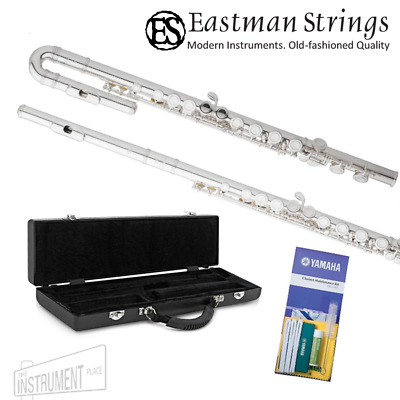Introduction
The flute is a woodwind instrument that is celebrated for its gorgeous, sweet tone. It also has a compact shape and size that make traveling to practice and performances a snap. The flute’s structure is simple: a graceful metal tube open on one end with holes arranged along its sides. Using small keys moved by the fingers, these holes can be alternatively covered or uncovered to create different notes and tones.
The flute is not made of one continuous piece of metal; it is divided into three sections called joints. These three are the head joint, the middle joint and the foot joint. These pieces are connected by thinner metal tubes called tenons.
Modern flutes are classified by the way in which the flute is positioned while playing and the pitch range of the flute. A flute could be side-blown (the most common type seen in orchestras), rim-blown and end-blown. The different types of pitch include: concert flutes in C, soprano flutes in E flat, treble flutes in G, bass flutes in C, alto flutes in G and tenor flutes in B flat.
A concert flute for a child is a great starting point for learning music. One of the most popular instruments in the world, the flute is played by people of all ages and skill levels. Flute repertoire is extensive: the instrument is used in school band programs, symphony orchestras, flute choirs, jazz ensembles, and as a solo instrument. Popular, classical, jazz, and even rock music has been either written or transcribed for the instrument.
Why Play the Flute
How to Play the Flute
Below is a video series introducing the parts of the flute and how to get started.
How to Assemble a Flute
How to Hold the Flute
How to Make a Sound on the Flute
Getting Ready to Play
Playing the First Note on Your Flute
How to Tongue on the Flute
Which Flute Should I Choose?
The Orchestra Place requires all students to have an instrument from the teacher-approved brand list to ensure the best experience and sound for the student and the ensemble.
For beginners, we recommend Eastman Strings as the best flute for quality and affordability.

The Andreas Eastman student flutes are constructed with a silver plated nickel silver body, head joint and C foot joint. These flutes feature plateau keys and an offset G key to provide a more comfortable playability for the younger player while producing a full sound and easy response. Eastman flutes are crafted from the highest quality materials to meet the demands of all student players in terms of both durability and artistry.
Back to topHow to Choose the Right Flute Size for My Child
Beginner school bands usually introduce the flute in the fourth or fifth grade. It is important for young players to be large enough to reach the keys without straining the neck or hands. For an eager student whose reach is not long enough, flutes with curved headjoints are available; many flute manufacturers offer a beginner model instrument featuring both a standard and a curved-style headjoint. The curved headjoint makes it possible for a young flutist to hold the instrument without having to reach beyond his or her capabilities at first.
As the student grows, it is a simple matter to change over to the traditional, straight headjoint. Be sure to check with your local music dealer, band director, or flute teacher when deciding whether to purchase the extra headjoint option. Purchasing a regular flute and discovering later that the student really needs the curved head means you’ll be purchasing both the curved headjoint and another case as well.
Back to topHow to Buy a Flute
After a young flutist has at least a year of experience, buying an instrument is often the best choice, financially and in sense of ownership. Your student has demonstrated their commitment and is ready to maintain and practice on their very own instrument. Since purchasing a flute is a bigger investment than renting, it’s important to make sure you’ve carefully compared retailers’ inventory, prices, financing options, setup and equipment options prior to buying. If and when you are ready to commit and invest in purchasing a flute, keep in mind the following guidelines and tips.
A silver or silver-plated flute from a well-known brand will withstand time and serve you much better sound-wise. If shopping for a beginner, one of good quality should be:
- easy to play,
- light to hold, and
- able to take some damage bound to occur from drops and hits.
Look for one with closed holes, split E mechanism, and C footjoint. These three specifications will help in making the flute easier to play when starting out and enable you to resell it at a higher value.
If the beginner/student is a small one, consider a flute with a curved head piece. Though it may cost a bit more, a curved headed flute can be helpful in reducing the amount of stretch a child’s arms would have to make when learning. Intermediate and professional flutes on the other hand will often be heavier and produce fuller sound and greater projection.
Back to topHow Much Should a Flute Cost?
Beginning flutist should be prepared to pay around $200-$500. A flute that costs less than $200 is unlikely to deliver good sound or hold up after time. You may find yourself having to replace components and fittings, which will cancel out the low initial cost of the instrument.
Experienced flutists will spend around $3000 or more depending on the brand and model.
Back to topRent-to-Own or Lease-to-Own Flute Options
Installment plans are an excellent option if you’re ready to make the commitment of buying an instrument but can benefit from deferred payments. This way, you get the freedom to pay over time, with the ultimate reward of owning the instrument. If you choose a rent-to-own or lease-to-own option, however, it’s important to check the fine print to make sure there are no hidden fees, and you should investigate the cancellation policy as well. Never sign up for a plan that traps you into payments if your child loses interest in playing an instrument. Look also for retailers who offer affordable damage protection during the installment term.
Our instrument supplier, The Instrument Place, offers teacher-approved instruments and one of the best interest-free lease-to-own programs as part of their commitment to getting an instrument in the hands of every person who wishes to play, without it being a financial burden.
Back to topRecommended Flute Accessories
When buying a flute, look for a store that offers all the accessories your child will need in order to best use and maintain it. A protective carrying case allows for easy transportation and a care kit keeps your flute looking and sounding like new over time. If given the option to purchase a music stand, go for it! A music stand promotes proper playing posture, which helps to prevent back aches and hunching over.
The Instrument Place instrument outfits come equipped with everything needed to get started in class, plus a free music stand with every instrument purchase!
Back to topFlute Maintenance and Care
Assembly
- Always consult your teacher if you are not sure how to put together your instrument.
- NEVER force the parts of your instrument together.
- When assembling the flute only hold the non-keyed parts (the barrel and the bottom of the foot).
- NEVER use lubrication of any kind.
Maintenance
- Every flute player should have a flute maintenance and care kit.
- Wipe off your fingerprints after every use. A clean, non-treated cotton cloth will work the best. If you do choose to use a treated cloth, be sure that it is for a SILVER finished instrument. Using the wrong cloth could cause scratches.
- Clean out the moisture from your instrument with an absorbent cloth. Clean the inside of all 3 sections of the flute. Removing the moisture from your flute before putting it away each time will prolong the life of the pads.
- Do not flush water through your flute.
- Always store your instrument in its case with the lid closed when not in use. This will prevent any excess tarnishing and lower the risk of damage.
- Do not put anything (including sheet music) inside the case with your instrument that does not belong. Closing the case with extra contents can cause damage to the delicate keys. Also, make sure that all the latches are securely closed before transporting your instrument.
Student flute prices can be considerable so take care of your instrument.
Back to topFamous Flutists
Looking for more inspiration? Below are sound bites from famous flutists from all a range of music categories.
Famous classical flute players include James Galway, Jeanne Baxtresser, Shri Hariprasad Chaurasia, Taffanel, Gaubert, Marcel Moyse, Michel Debost, Joseph Mariano, Mimi Stillman, Alexa Still and Marian Gedigian.
Well known jazz flute players include Herbie Mann, Eric Dolphy, Jeremy Steig, Herbie Mann, Hubert Laws, James Moody, Frank Wess, Brian Jackson, Rahsaan Roland Kirk and Bobbi Humphries.
In rock and pop music, Ian Anderson and Greg Patillo are noted names.
Back to top